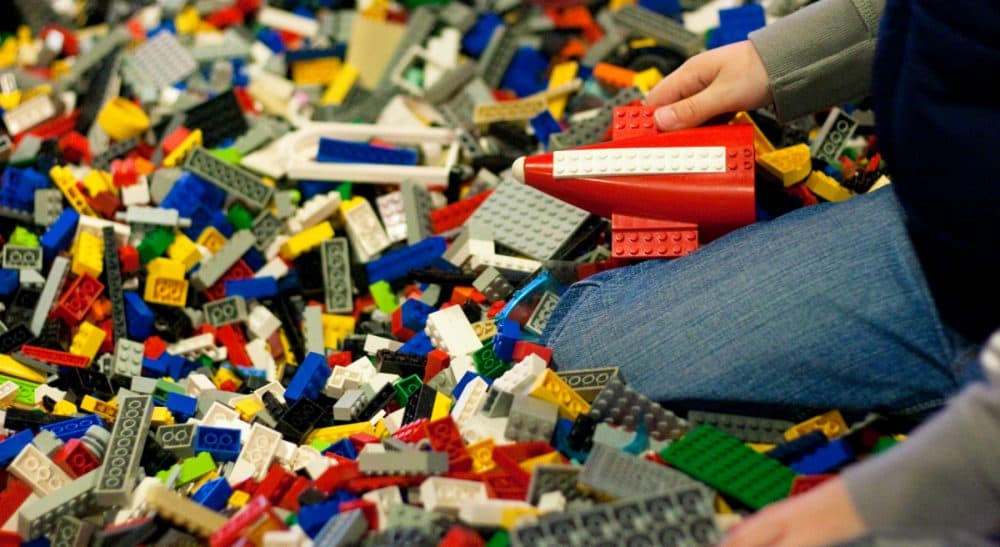Advertisement
My Lego Dilemma

Legoland Discovery Center Boston opens on Friday at Somerville’s Assembly Square. As the only Legoland in New England, the Boston location will doubtless be a hit, having an impact on the local economy as well as local traffic patterns. The first week of tickets, which cost from $18 to $22.50, are already sold out.
Our local, 44,000 square foot mecca to all things Lego includes such attractions as a Lego Factory Tour, 4D Cinema, Kingdom Quest Laser Ride and birthday party rooms. There’s even a “Miniland” reproduction of local landmarks such as Fenway Park, Logan Airport and the Zakim Bridge. Not surprisingly, the attraction also provides visitors with plenty of opportunities to buy Lego products.
Legos aren’t toys for toys sake, but brands and experiences (and sexist ones at that).
But to my mind, this latest addition is a part of a more disturbing effect: the Lego-ization of childhood. Brick by brick, the once innocuous building toy has become a world-girdling, multimedia kingdom, now encompassing movies, video games and theme parks, and dominating the landscape of our children’s leisure time.
Some facts about Lego’s rise: In 2013, Lego Group racked up $4.72 billion in sales, $1.35 billion of that in the U.S., even during a declining toy market. Over the past decade, company revenue has quadrupled, and sales have grown by double-digit percentages between 2005 and 2012 in every year but one. Behind Mattel and ahead of Hasbro, the Denmark-based company has become number two among its U.S. toy-making counterparts. Lego estimates that, collectively, children have spent 5 billion hours per year playing with its toys.
How did the brand become a staple of boys' childhoods? (And, yes, it's mostly boys.) For one, from lucrative partnerships with major entertainment franchises and products such as Star Wars, X-Men, The Simpsons, Mini Cooper, the Red Sox and Spongebob Squarepants. No fewer than 17 building sets and Lego Minifigures series were released to accompany "The Lego Movie," which has made $458 million globally and $253 million domestically at the box office.
These Legos ain't cheap, either. My nephews request Lego Indiana Jones and Lego Lord of the Rings sets each birthday and Christmas. A medium-sized set, such as “The Hobbit: The Desolation of Smaug Dol Guldur Battle” set retails for around $51.99. The 5,195-piece “Ultimate Collector's Millennium Falcon” retails for $500. Then there are LEGO video games. Connected to such properties as Batman, Star Wars and Marvel, or in-house brands like LEGO Ninjago: these games cost $30 a pop. Not to mention Lego-branded merchandise, from watches to key chains to sleeping bags.
Advertisement
Lego’s amazing innovation was always this: open-ended, creative, problem-solving play. Now, Lego encourages buying and collecting.
When I was a kid, I owned a handful of un-branded kits — trucks and airports, firehouses and castles — which encouraged me to come up with my own kooky ideas. These generic sets still exist, but are now dominated by themed sets bound to profitable properties. A kid constructs a fancy Imperial Star Destroyer and puts it on a shelf like a priceless artifact. At 11 bucks, the 2013 All Star limited edition David Ortiz Minifigure is more collectible action figure than creativity expander.
As Lego is now shaping playtime for an entire generation, the brand is also coming under fire — rightfully — for reinforcing gender stereotypes. Ninety percent of kids who played with Lego in 2011 were boys and 80 percent of Lego characters were male. In recent years, realizing it was losing the gender wars, Lego has released more than 40 girl-oriented building sets. They’ve done well. The "Lego Friends" line is now the brand’s number four seller, and by the end of 2012, the number of girl Lego consumers had tripled.
Brick by brick, the once innocuous building toy has become a world-girdling, multi-media kingdom, now encompassing movies, video games and theme parks, and dominating the landscape of our children’s leisure time.
But the pastel-hued Friends line effectively turns Legos into mini Barbies who hang out in cafes and beauty shops. Sets have themes like "Summer riding camp," "Stephanie's Soccer Practice” and "Heartlake High." Lego figurines are by definition blocky, but these new female figurines are curvy. In February, in a widely reposted story, a 7-year-old girl complained that, effectively, Lego Friends were sexist. "All the girls did was sit at home, go to the beach, and shop, and they had no jobs,” she wrote in a letter, “but the boys went on adventures, worked, saved people, and had jobs, even swam with sharks."
As Legoland colonizes our backyard, I worry we’ve reached a tipping point. The Discovery Center represents a final encroachment. Legos aren’t toys for toys sake, but brands and experiences (and sexist ones at that). The plastic blocks have become a gateway for a series of pop culture consumption habits. Kids can’t simply be kids; they feel pressured — and put pressure on their parents — to buy into new products and new theme parks.
To simply have a toy and play with it, and to build something cool and unique, is no longer enough.
Related:
